Ground Source Heat Pump Cost
Last updated 27th February, 2024
What does a ground source heat pump cost?
Everything you need to know about installing a ground source heat pump (GSHP), which usually costs around £15,000-£22,000 to install. If you're interested in an underground heating system you've come to the right place!
Continue reading below!
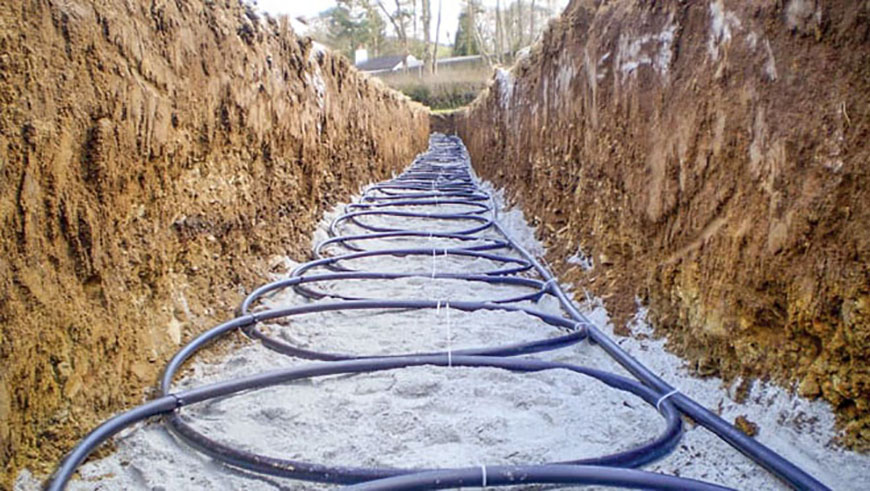
How Much Do Ground Source Heat Pumps Cost?
The cost of installing a ground source heat pump varies greatly, influenced by factors such as property location, your home energy needs, the type of heat pump (whether you are installing a horizontal or vertical array) required, and the groundwork required to install the array – which is the biggest discrepancy in pricings.
The UK average cost of home heat pump systems is around £1,350 per kW of capacity of your heat pump - typically, the cost of groundworks for a horizontal array is one-third of the price of a vertical array to install. A horizontal array capable of delivering 8kWh will cost in the region of £15,950, whereas a vertical array of the same capability will cost roughly £21,950 to install.
Whilst ground source heat pumps are not cheap to install, they have considerably lower running costs than traditional home heating systems and, once installed you may be eligible for funding through Ofgem for each eligible unit of energy produced.
Ground Source Heat Pump Prices
The cost of having a ground-source heat pump installed at your property will vary according to the amount of pipework needed and the set-up that best suits your situation, but as a guide you can expect the following costs for labour and installation:
| Type of GSHP | Heat pump capacity | Cost |
|---|---|---|
| Horizontal | 5kW | £11,150 - £12,650 |
| Horizontal | 8kW | £14,750 - £17,150 |
| Horizontal | 15kW | £23,150 - £27,650 |
| Vertical | 5kW | £17,150 - £18,650 |
| Vertical | 8kW | £20,750 - £23,150 |
| Vertical | 15kW | £29,150 - £33,650 |
Additional Costs
There are a number of additional or extra costs that may be worth investing in whilst having your ground source heat pump installed on your property, with many of them working hand-in-hand with the efficiency of your ground source heating pump:
Loft Insulation – Cost: £250
Efficient home insulation plays an integral role in the effectiveness of installing a GHSP system in your home. Good quality loft insulation ensures your home is more energy efficient and can therefore reduce the amount of heat (and therefore energy) needed in your property to achieve desired temperatures.
Cavity Wall Insulation – Cost: £500
Similar to loft insulation, cavity wall insulation increases your home energy efficiency and is vital in ensuring your GSHP can operate effectively.
Underfloor Heating – Cost: £1,750
Unlike traditional radiator systems, underfloor heating requires much lower temperatures to bring a home to the desired temperature. Underfloor heating is therefore ideal when used in conjunction with a GSHP system as the energy needed to heat the water is reduced.
Install Double Glazed Windows – Cost: £3,500
It’s estimated that 10% of home heating is lost through insufficiently insulated windows in the average domestic property. Having double glazing installed (or replacing blown double-glazing) will increase your home insulation.
Alternatively, it might be worth having secondary glazing added to existing windows (which is particularly useful for listed buildings where new windows are not permitted), costing, on average, £1,500 for a standard 3-bedroom semi-detached home.
Garden landscaping – Cost: Varies according to need
Whether you opt for a horizontal or vertical GHSP system, your garden will be impacted by the presence of heavy machinery and extensive groundwork to install the needed materials. Once the GSHP has been placed, your garden will likely look unsightly and you will likely want to undertake some form of landscaping to bring your garden back to life.
For an instant lift, consider laying new turf to cover up the disturbed earth (at a rough cost of £700 for 50m2), and applying a lawn treatment to help your garden regain some of its vigour.
Cost Breakdown Calculator
The cost of installing a ground source heat pump, assuming a horizontal array capable of delivering 11kW: £20,000
Materials
£18,000
Labour
£2,000
Waste Removal
£0
Labour Costs and Time Frames
Installation of a ground source heat pump usually takes 1 – 2 days to complete for a team of workers, with most engineers charging an average of £50 an hour, or the equivalent of £350 per day in labour charges for their time.
The time taken to complete the installation will usually vary according to factors such as site accessibility and the overall scale of the installation itself, with more energy-demanding homes requiring more pipework and groundwork, resulting in a longer installation process.
Table of Contents
- How much does a ground source heat pump cost?
- Labour costs and time frames
- What is a ground source heat pump?
- How does a ground source heat pump work?
- What does installing a ground source heat pump entail?
- Cost affecting factors of installing a ground source heat pump
- Choosing a ground source heat pump
- Installing a ground source heat pump DIY
- Planning permission for ground source heat pump
- Building regulations for ground source heat pump
- Running costs of a ground source heat pump
- Benefits of installing a ground source heat pump
- Conventional heating vs ground source heat pump
- Are ground source heat pumps good for the environment?
- Renewable heat incentive for ground source heat pumps
- Emergency plumbing ground source heat pump
- Ground source heat pump maintenance
- Cost of removing a ground source heat pump
- FAQs
- How to find & hire ground source heat pump installers
- Sources
What is a Ground Source Heat Pump?
A ground source heat pump is a central heating system that draws solar energy from the ground into the home. The modern heat pump was developed during in 1940s, though the technology has been around since 1700s.
Ground source heat pumps have gained in popularity over the years as they have been recognised for their energy efficiency and eco-friendly approach to heating as the system itself produces no emissions.
The Department for Business, Energy and Industry current operate a Renewable Heat Incentive to persons with eligible GSHPs, offering an average of 20p per kW of energy produced using the system – which has incentivised many homeowners to upgrade their heating systems.
How Does a Ground Source Heat Pump Work?
Heat pumps work in a very similar fashion to refrigerators, in that they transfer heat (or energy) from one location to another – in this case, solar heat stored in the ground to your home.
Horizontal heat pump set-ups absorb heat over a large surface area at a depth of around 1.5 metres in the ground, affected by the ground temperature and heat from the sun. Vertical set-ups, on the other hand, bore deep underground, at a depth of up to 100m.
An antifreeze liquid is pumped through the ground loop pipework in your garden, gaining in temperature as it passes along the system and is then drawn into a compressor which raises the temperature of the liquid before the heat exchanger transfers the heat to a separate body of water.
The heated water is then used to heat your home – once cool again, the liquid is pumped back into the ground pipework and the cycle continues.
Ground source heat pumps work most effectively with newer-build homes as they tend to be less prone to draughts and are typically better insulated than older homes – a factor that drastically impacts the overall effectiveness of your GSHP and how much pipework is required to draw adequate energy.
In addition to this, underfloor heating is recommended as it requires overall lower temperatures to maintain ambient temperatures – you can still use conventional radiators, but they will require more energy to run effectively, which in turn means that your home heating costs will not be reduced as effectively.
What Does Installing a Ground Source Heat Pump Entail?
The first step in installing a ground source heat pump is to ensure your home is well-insulated; a poorly insulated home will cost more to heat, which in turn will mean more pipework will need to be laid in order for your ground source heat pump to be effective, which will cost you more to both install the pump and heat your home.
You should consult with a ‘Microgeneration Certification Scheme’ accredited engineer prior to committing to a ground-source heat-pump; they will check soil condition and assess the best set-up to meet your home energy needs and property type, as well as assess the space available for the installation.
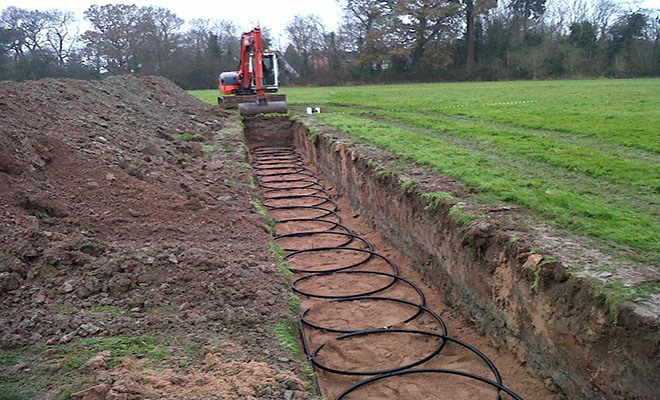
How much soil needs excavating will depend on your property size, heating demands and the type of ground source heat pump you are installing:
- For horizontal ground source heat pumps trenches will need to be dug (the average depth varies from 0.5m to 2m depending on the soil type and amount of pipework needed) usually over a 200-500m2 area and the pipes will be laid either in coils or a serpentine configuration.
- Vertical ground source boreholes (between 1 – 3 on average) will need to be dug at a depth ranging from 50-150m deep to accommodate the pipework.
Your contractor will then make amendments to your heat distribution infrastructure if necessary. If you are having wet underfloor heating installed, it would be completed at this point.
The heat pump can now be connected to your homes’ ductwork and the ground loop of pipework ready to be used.
Cost Affecting Factors of Installing a Ground Source Heat Pump
Like most purchases, there are a number of factors that can affect the overall cost of having a ground source heat pump installed on your property.
The type of heat pump, whether vertical or horizontal, will affect the cost. Horizontal pumps are cheaper to install as they will require less heavy machinery to dig up the earth compared to digging vertical boreholes – however, vertical heat pumps are slightly more consistent with their ability to draw heat from the earth during the colder months, meaning the CoP (Coefficient of Performance) is more consistent throughout the year compared to horizontal layouts.
The size of the system required will be influenced by your home energy demands and property size; ensuring your home is well insulated can help reduce the demand for energy.
Regardless of which system you have installed, there will still need to be extensive groundworks to excavate soil in order to lay the pipework. Horizontal GSHPs require trenches to be dug out, usually at a depth of 1.5 metres for effective heat conduction. Vertical GSHP require boreholes of a depth of around 100m each to be effective. The type of soil in the ground and ease of access to the property for machinery and labourers will affect this costing.
Geothermal energy is location specific, meaning you may require more (or less) materials in order for your GSHP to draw power effectively, which will influence the cost of the installation.
The size of the pump itself needed to power your home will have an impact on the costing, with larger pumps and more material understandably costing more to install. Your GSHP specialist will calculate the necessary size you require to meet your energy needs.
Choosing a Ground Source Heat Pump
There are two main types of ground source heat pumps available on the market – horizontal and vertical - each with their own pros and cons that should be considered before committing to a purchase. GSHPs also come with overarching pros and cons to consider.
Pros and cons of installing a ground source heat pump
Pros
- ✔ May be eligible for the Renewable Heat Initiative (RHI) grant to recoup investment costs
- ✔ Low maintenance and running costs, with an estimated 10% – 20% return on investment per year for the lifespan on the pump depending on RHI eligibility
- ✔ Very energy efficient
- ✔ Long lifespan (estimated at between 50 – 100 years) compared to traditional home heating methods
- ✔ Can increase your property value
- ✔ Greener than traditional home heating systems
Cons
- ✖ High up-front cost of installation
- ✖ Disruptive installation with significant requiring groundwork
- ✖ Performance is affected by ground type
If you are going to install a ground source heat pump at your property, consider your property size, the energy demand of your home and the location of the unit and decide the most appropriate type for your needs - both types of ground source heat pump have their own merits and disadvantages to consider.
Horizontal Ground Source Pump Cost
Average cost - £11,150 – £27,650
Pros
- ✔ Cheaper to install than a vertical GSHP
- ✔ Does not require specialist machinery to dig the trenches
Cons
- ✖ Less energy efficient than a vertical GSHP during colder months
- ✖ Requires a large external space to be effective
- ✖ The ground above the horizontal collectors cannot be used for tree growth, pond installation or driveways after the GSHP has been installed as these will alter the effectiveness and could cause disruption to your energy supply.
Vertical Ground Source Pump Cost
Average cost - £17,150 – £33,650
Pros
- ✔ Suitable for smaller external spaces
- ✔ Maintains effectiveness during the colder months
- ✔ Minimises space needed for effecting conduction
Cons
- ✖ More expensive to install than a horizontal GSHP
- ✖ Requires specialist machinery to bore holes in the ground
Installing a Ground Source Heat Pump DIY
If you’re looking to qualify for the Renewable Heat Incentive (RHI) grant, your heat pump will need to be installed by a professional that is Microgeneration Certification Scheme (MCS) accredited.
Even if you are not applying for the RHI grant, it’s still not recommended that you install your ground source heat pump yourself because of the complexity and safety aspects of the work – But there is some preparation work can be undertaken DIY ready for your professional to install the ground source heat pump system for you.
- You could dig-out the trenches yourself to save some money prior to the installation if you opt for a horizontal set-up – but you should confer with a professional beforehand regarding the depth and layout of the trenches and make sure you have enough room to accommodate the pipework in your garden beforehand.
- You can clear access paths for your installer and any machinery that is needed on-site to complete the work.
- If you are having a large GSHP system installed, you will also need to clear your plant room (the room in which the heat pump and hot water cylinder will be installed, which is usually located in a utility room, garage or basement). Depending on your model, the heat pump may be compact enough to install inside a kitchen cupboard, though they can be considerably bigger – again, you should discuss your needs with a recognised professional who will be able to advise the best size and location of your heat pump.
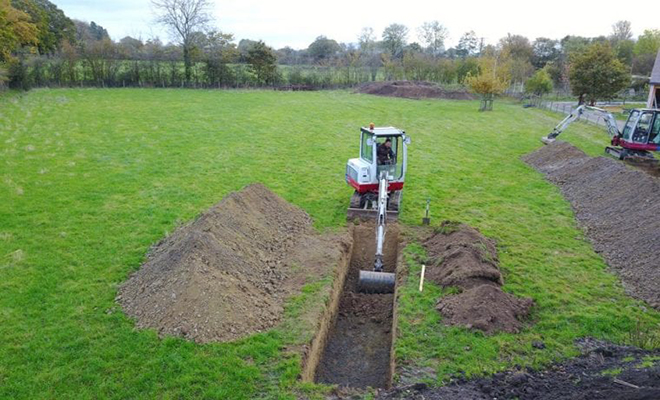
Installing ground source heat pumps is labour intensive and involves several bulky or heavy components (heat pumps weigh, on average, over 200kg), as well as working with COSHH rated materials and requires specialist procedures to ensure correct operation of parts.
In addition to this, a professional with experience will be able to determine the correct amount, and configuration, of pipework for your property energy needs and ensure it is correctly laid to be effective.
Once the ground source heat pump has been installed, it will need to be signed off by an accredited MCS professional who will supply you with a certificate that you can present whilst applying for the RHI grant.
Planning Permission for Ground Source Heat Pump
In most cases ground source heat pumps are considered permitted development and do not require planning permission. The exception is if you live in a listed building or conservation area, in which case, you should contact your local council for their requirements.
In the event that planning permission is required, you can the planning portal fee calculator (available for homes in England), though the average cost is in the region of £200.
Building Regulations for Ground Source Heat Pump
As with any home installation you are required to comply to building regulations which deal with the technical and structural details of a planned home development, with Part L stipulating rules regarding high-efficiency alternative systems for heating homes and home energy efficiency ratings.
The cost of building inspection fees varies for each local authority and need to be undertaken to ensure your proposed installation is in line with building regulations.
Running Costs of a Ground Source Heat Pump
The cost of running a ground source heat pump is influenced by the Coefficient of Performance (COP) – which is measured by comparing the energy used and energy generated.
Usually ground source heat pumps have a COP of around 4.0, which is to say for every kW of electricity used to power the pump, 4kW of heat are produced. The actual cost of running the heat pump will be determined by your electricity tariff.
There are three factors that will directly impact the running cost of your ground source heat pump:
- The efficiency of the pump
- The temperature of the heat source i.e. ground temperature
- The amount of heat it needs to generate for your home
Larger homes will, unsurprisingly, require more heat to be produced by the ground source heat pump in order to maintain ambient temperatures throughout your home.
If your ground source heat pump has been installed by an accredited MCS engineer, your operational costs can be further reduced if you are eligible for the Renewable Heat Incentive, which offers retrospective payments for the energy your ground source heat pump produces.
Benefits of Installing a Ground Source Heat Pump
Ground source heat pumps, once correctly installed, offer a multitude of benefits:
Environmentally Friendly
Ground source heat pumps are considered a renewable source of energy. Whilst they require electricity to operate, the amount of power that is needed to operate the heat pump is greatly reduced in comparison to traditional home-heating methods, resulting in reduced home carbon emissions.
Safe and Reliable
Ground source heat pumps are considered safe as there are no exposed elements that can pose a hazard to children or pets once they have been installed. Ground source heat pumps do not use flammable materials or require fuel storage tanks as the heat is drawn directly from the earth, meaning they are a reliable source of constant energy.
Increase Value of Property
Ground source heat pumps can increase the value of your property by reducing the amount of money it costs to heat your home. Typically, in order for a ground source heat pump to function at its best, your home will need to be well insulated, which results in a better energy efficiency rating – another positive impact on property value.
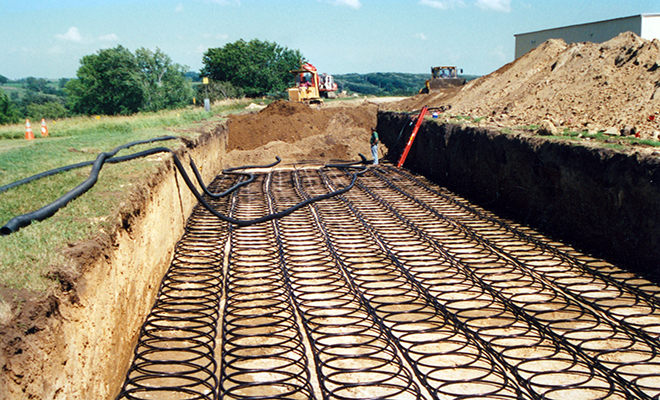
Low Maintenance
Once installed, ground source heat pumps are incredibly low maintenance, especially when compared to traditional home heating systems. It’s recommended that you undergo a maintenance check once a year to ensure the heat pump is operating within the manufacturer’s tolerances which could otherwise negatively impact effectiveness.
These checks can either be completed by yourself or a qualified professional – though if a fault is found, an engineer with an ‘F Gas’ qualification will be required.
Fully Automated
Heat can be produced at any time, without having to add fuel to the system, and can be set to be fully automated, so your home will stay a consistent heat without intervention on your part.
Efficient
The average UK ground pump heat source has a Co-efficiency of Performance of around 4.0, meaning for every kW of electricity used to power the pump, 4kW of heat are generated.
Can Save You Money in the Long Run
Because heat pumps are much cheaper to operate than oil or electric boilers, you will save money on your home heating bills. In addition to this, if you qualify for the renewable heat incentive, you will receive a payment of roughly 20p per kW of eligible energy produced by your ground source heat pump for seven years.
Conventional Heating vs Ground Source Heat Pump
The price of installing a ground source heat pump might seem daunting, with replacing your home boiler appearing to be a more budget friendly option – with an average cost of between £2,000 - £2,500 – but it’s important to remember that whilst the initial outlay is cheaper for a boiler, the overall running costs are not, especially when compared to ground source heat pumps and taking into consideration renewable heat incentive payments.
Whilst conventional heating typically uses non-renewable energy or fossil fuels to generate 100% of their heat, ground source heat pumps are considered renewable energy as the majority of the heat produced is drawn from latent heat in the earth.
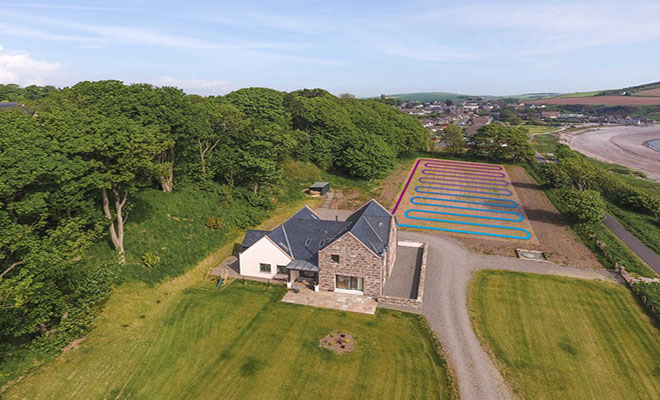
An advantage of choosing conventional heating is compatibility with older heating systems and pipework, unlike ground heat pumps that may require an infrastructure upgrade in order to run efficiently once installed.
Conventional boilers are also capable of producing higher levels of heat in your home – which may be an issue for ground heat pumps if insulation is not adequate in your home, which will impede its efficiency.
It’s estimated that the average home using a conventional electric boiler cost roughly £1,990 annually to heat a home, compared to an estimated cost of £750 using ground source heating.
Are Ground Source Heat Pumps Good for the Environment?
Ground source heat pumps are considered good for the environment, particularly in comparison to traditional home heating methods.
Ground source heat pumps do not produce emissions in themselves, and the power used to generate heat is much smaller compared to traditional methods – ground source heat pumps generally average 1kW of electricity consumption to every 4kW of heat produced, which in turn reduces your home carbon footprint.
Because GSHPs absorb heat from the earth it is considered a renewable energy source, only requiring a fraction of power to convert the heat compared to a fully electric, oil or even gas boilers in traditional home heating systems.
Renewable Heat Incentive for Ground Source Heat Pumps
The Renewable Heat Incentive (RHI) is an government financial scheme available in England, Scotland and Wales which promotes the use of renewable heat sources as a means of reducing the UK’s carbon emissions.
The RHI offers quarterly payments for a period of seven years for eligible, green energy produced by the heating system.
The amount of money you will receive will vary according to the size of your home system and property, but as an indication:
- If your home demands 15,000kWh per year in heat;
- Your ground source heat pump has a seasonal performance factor of 3 (as indicated on your MCS certificate);
- 15,000kWh x (1- 1/3) = 10,000kWh is your estimated renewable heat output per year
- And you receive a GSHP tariff of 20.89p/kWh
- Tariff rate x estimated renewable heat output = £2,089 annually
- You would receive quarterly payments of £522.25
To be eligible to apply for the RHI, the following criteria must be met:
- You must be able to produce a domestic Energy Performance Certificate (EPC).
- Your heat pump must be on the Product Eligibility List.
- Your renewable heating system and installer must be registered under the Microgeneration Certification Scheme.
- You must be the owner of an eligible heating system
- You must own or occupy the property the heating system is in
For further information regarding eligibility criteria, you can view the Ofgem essential guide for applicants here. For further information about the RHI in general, including tariffs and how to apply, you can visit the Ofgem Renewable Heat Incentive webpage here.
You may also be eligible for financial help under the Green Deal, which helps towards the cost of energy-saving home improvements for eligible households depending on your local authority.
Emergency Plumbing Ground Source Heat Pump
Ground source heat pumps have a reputation of being virtually maintenance free, due to their lack of moving parts – but that’s not to say that they are immune from encountering issues from time to time, in which case you may need to contact an emergency plumber to service your pump before further issues arise.
If you notice an issue with your heat pump, such as leaking or an unexpected decrease in efficiency that you are unable to rectify yourself, you should turn the system off and wait for your MCS registered plumber to arrive – Leaving the system on could worsen the issue and cause further damage to the system or your property.
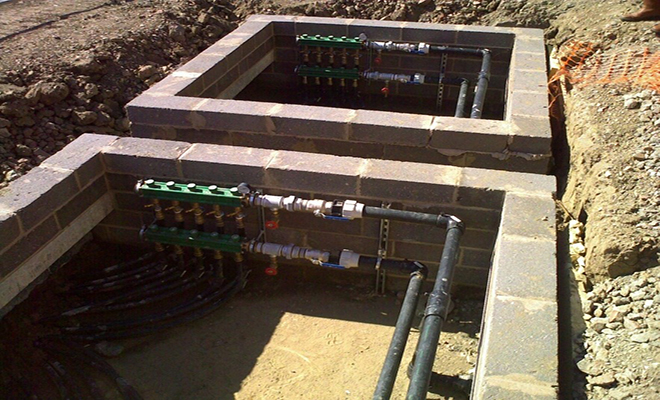
Typically, emergency plumbing costs start at around £180 for the call-out charge, which usually covers the first 30 minutes of the plumbers visit, incurring an additional charge for every 30 minutes thereafter to rectify your issue.
Because of the nature of heat pumps and the toxic materials used (antifreeze within the ground loop), you will need a registered professional that holds a “F” gas certificate, which is proof of their ability to manage and maintain heat pumps as well as the hazardous materials they contain – the same type of engineer you would require if your refrigerator broke.
Ground Source Heat Pump Maintenance
Ground heat pumps, once installed, are virtually maintenance free due to their lack of moving parts – though it is recommended that they are inspected at least once a year to ensure they are functioning correctly, with maintenance checks a requirement for eligibility of the RHI funding scheme.
Depending on the make and model of your ground source heat pump, advice on maintenance checks will vary – though it is generally recommended that the system is checked over at least once a year, before the heating season, to ensure it is in working order.
Maintenance checks can be undertaken yourself – or you may wish to employ a qualified engineer, with an average cost of around £90.
As a guide you will likely need to inspect the following:
- The control equipment
- Above ground pipes and connections
- Condition of your home heating infrastructure; do the radiators need bleeding?
- The water pump condition
- The concentration of coolant fluid in the ground array
Your user manual will outline the exact checks that will need to be undertaken, and how they should be completed.
Cost of Removing a Ground Source Heat Pump
Ground heat pumps have an average life expectancy of around 25 years on average, with the underground pipework expected to last for up to 75 years – though there may be an occasion in which it is necessary for you to have your heat pump removed from your property, such as a system upgrade for example.
In the event of uninstalling a heat pump, you can expect to budget roughly £700 for your specialist engineer to remove the system from your property.
FAQs
How to Find & Hire Ground Source Heat Pump Installers
Your engineer should hold an F Gas certificate which proves they are qualified to handle your heat pump, and will preferably either be part of the Microgeneration Certification Scheme or Competent Person Scheme if you intend to apply for the Renewable Heat Incentive (which is mentioned in the eligibility criteria).
Ideally, you should talk to neighbours or friends that have had similar work undertaken and ask them about their experience with their installation professional, including the length of time taken to install their heat pump, the professionalism demonstrated and if any issues occurred during the installation process, though if you are unable to contact anyone regarding this the majority of companies should have a portfolio of their work available to you.
You should get a minimum of three quotes to ensure you are paying a fair price for the work proposed. If you are unsure who best to contact, you can get three free quotes from local, trusted suppliers here.
Sources
https://www.gshp.org.uk/
https://energysavingtrust.org.uk/renewable-energy/heat/ground-source-heat-pumps
https://www.greenmatch.co.uk/green-energy/grants/rhi
https://www.uswitch.com/energy-saving/guides/ground-source-heat-pumps/
https://www.renewableenergyhub.co.uk/main/heat-pumps-information/the-history-behind-heat-pump-technology/
https://mcscertified.com/
https://www.gov.uk/building-regulations-competent-person-schemes
https://www.ofgem.gov.uk/environmental-programmes/domestic-rhi










